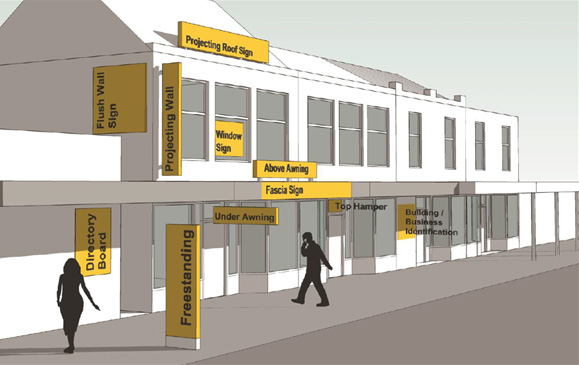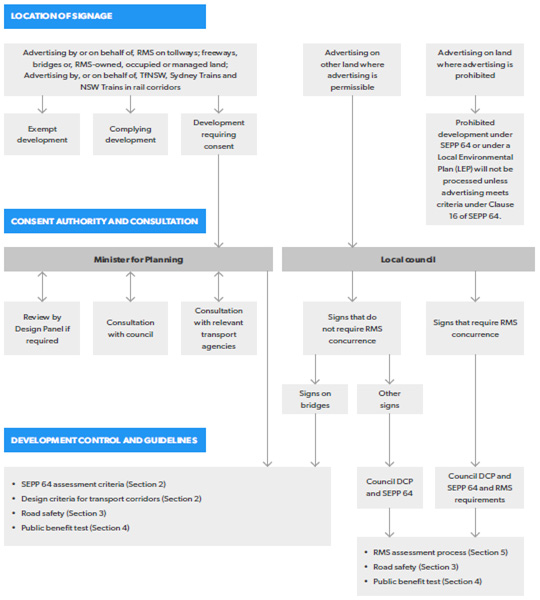Signs and advertising structures
Signs and outdoor advertising are important elements of vibrant urban places. They are part of the landscape, especially in commercial, mixed use and industrial settings. Signs can be important for communication and to convey messages that help us identify buildings, shops, products and services.
However, signs can easily dominate and clutter the landscape. Signs that are visually dominant or poorly located are discouraged.
Definitions
What is signage?
Signage means any sign, notice, device, representation or advertisement that advertises or promotes any goods, services or events and any structure or vessel that is principally designed for, or that is used for, the display of signage, and includes any of the following:
- An advertising structure
- A building identification sign
- A business identification sign
but does not include:
- A traffic sign
- Traffic control facilities.
Sign types

Source: Leichhardt Development Control Plan (DCP) 2013
What is an advertising structure?
A structure used or to be used principally for the display of an advertisement.
What is an advertisement?
A sign, notice, device or representation in the nature of an advertisement visible from any public place or public reserve or from any navigable water.
What is a billboard?
A billboard is a generic term used to describe a large advertisement. Generally a billboard is not permitted in residential zoned land.
Do all outdoor advertising signs need Council approval?
No, some signage may be erected without the need for formal approval. Reference should be made to Exempt & Complying Development Codes 2008.
Signage controls
For residential, commercial and industrial zones
Refer to the current regulations section of this page.
For mixed use buildings, sex service premises
Refer to the current regulations section of this page.
Signage controls for heritage conservation areas and heritage items
Refer to the current regulations section of this page.
Signage on RMS, Transport NSW and rail corridor lands
Jurisdiction over advertising signage by or on behalf of RMS, Transport NSW, Sydney Trains and other rail corridors associated with tollways, freeways, bridges or lands owned, occupied or managed by the above listed authorities sits with the NSW Minister for Planning.
Outdoor advertising and signage applications under State Environmental Planning Policy (SEPP) No. 64

Source: Transport Corridor Outdoor Advertising and Signage Guidelines: Assessing development applications under SEPP 64, NSW Department of Planning and Environment, November 2017
Illumination or light spillage from advertising structures
Where the advertising structure did not require formal council approval to be installed and operated issues such as light illumination/spillage and hours of operation, Council plays no part in the resolution of the matter. In these types of instances it is the responsibility of the affected parties to resolve the matter.
Where the advertising structure operates by way of formal development consent, Council has the ability to undertake an initial assessment of any reported amenity impacts including but not limited to lighting intensity/spillage and hours of illumination against the consent conditions.
Signage such as billboards is generally not permitted in any of the residential zones.
Seeking further assistance with outdoor advertising structures
If Council is the regulatory authority for the signage, residents are able to report associated issues as outlined:
- Request is logged with Council to investigate
- Council's development compliance team commences investigation, which involves review of files and consents
- If applicable, a possible site inspection is carried out to assess any possible impacts, which may influence an appropriate action to be undertaken by Council
- Actions may include: Issuing of a notice of intention to remove sign, warning/caution where appropriate, no action, monetary penalties.
Council's actions are undertaken in accordance with the Inner West Council Compliance and Enforcement Policy:
Current regulations
There are several controls which Council must consider when assessing advertising signage including size, intensity and location. The key legislative requirements are prescribed by:
- State Environmental Planning Policy (SEPP No.64) - Advertising and Signage
- The Marrickville Development Control Plan 2011 (DCP) Part 2.12 Signs and Advertising Structures
- The Leichhardt Development Control Plan 2013 (DCP) Part C1.15 – Signs and Outdoor Advertising
- The Ashfield Development Control Plan (DCP) 2016 Part A – Signs and Advertising Structures
Jurisdiction for the regulation of advertising signage by or on behalf of RMS, Transport NSW, Sydney Trains and other rail corridors associated with tollways, freeways, bridges or lands owned, occupied or managed by the above listed authorities sits with the NSW Minister for Planning.